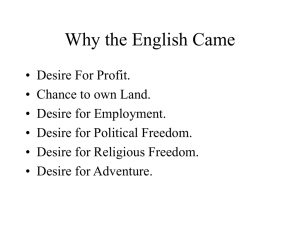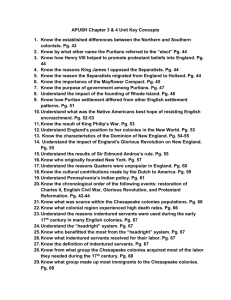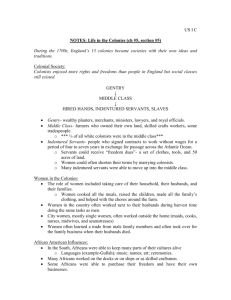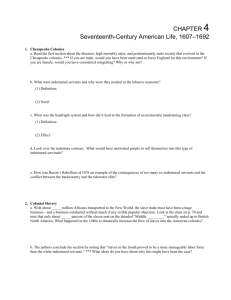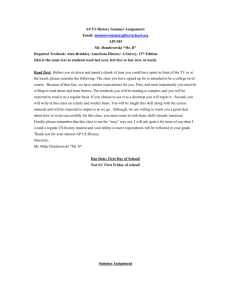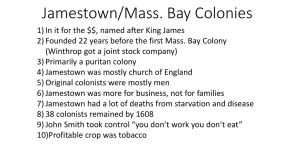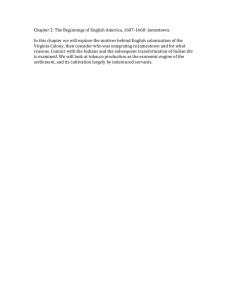Period 1 and 2 Test
advertisement
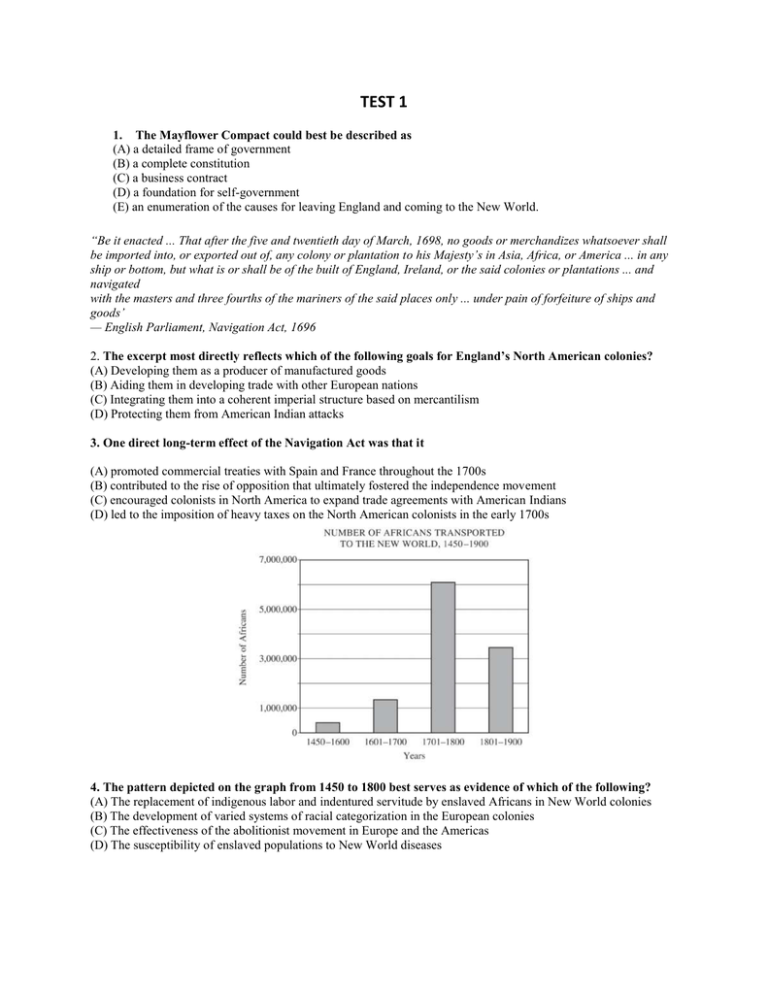
TEST 1 1. The Mayflower Compact could best be described as (A) a detailed frame of government (B) a complete constitution (C) a business contract (D) a foundation for self-government (E) an enumeration of the causes for leaving England and coming to the New World. “Be it enacted ... That after the five and twentieth day of March, 1698, no goods or merchandizes whatsoever shall be imported into, or exported out of, any colony or plantation to his Majesty’s in Asia, Africa, or America ... in any ship or bottom, but what is or shall be of the built of England, Ireland, or the said colonies or plantations ... and navigated with the masters and three fourths of the mariners of the said places only ... under pain of forfeiture of ships and goods’ — English Parliament, Navigation Act, 1696 2. The excerpt most directly reflects which of the following goals for England’s North American colonies? (A) Developing them as a producer of manufactured goods (B) Aiding them in developing trade with other European nations (C) Integrating them into a coherent imperial structure based on mercantilism (D) Protecting them from American Indian attacks 3. One direct long-term effect of the Navigation Act was that it (A) promoted commercial treaties with Spain and France throughout the 1700s (B) contributed to the rise of opposition that ultimately fostered the independence movement (C) encouraged colonists in North America to expand trade agreements with American Indians (D) led to the imposition of heavy taxes on the North American colonists in the early 1700s 4. The pattern depicted on the graph from 1450 to 1800 best serves as evidence of which of the following? (A) The replacement of indigenous labor and indentured servitude by enslaved Africans in New World colonies (B) The development of varied systems of racial categorization in the European colonies (C) The effectiveness of the abolitionist movement in Europe and the Americas (D) The susceptibility of enslaved populations to New World diseases 5. Which of the following is a correct statement about the use of slave labor in colonial Virginia? A. Profit-minded English merchants and the Crown forced it on reluctant White Virginians. B. It was the first case in which Europeans enslaved Africans. C. It fulfilled the original plans of the Virginia Company. D. It first occurred after the invention of Eli Whitney’s cotton gin, which greatly stimulated the demand for slave labor. E. It spread rapidly in the late 17th century, as Africans displaced White indentured servants in the tobacco fields. “Wherefore, security being the true design and end of government, it unanswerably follows that whatever form thereof appears most likely to ensure it to us, with the least expense and greatest benefit, is preferable to all others. . . . Here too is the design and end of government, Freedom and Security.” ---Thomas Paine, Common Sense, 1776 “[G]overnments are instituted among Men, deriving their just powers from the consent of the governed. That whenever any Form of Government becomes destructive of these ends, it is the Right of the People to alter or to abolish it, and to institute new Government, laying its foundation on such principles and organizing its powers in such form, as to them shall seem most likely to effect their Safety and Happiness.” ---Thomas Jefferson, Declaration of Independence, 1776 6. The excerpts were written in response to the (A) British government’s attempt to assert greater control over the North American colonies (B) British government’s failure to protect colonists from attacks by American Indians (C) colonial governments’ failures to implement mercantilist policies (D) colonial governments’ attempts to extend political rights to new groups 7. The ideas about government expressed by Paine and Jefferson are most consistent with which of the following? (A) The concept of hereditary rights and privileges (B) The belief in Manifest Destiny (C) The principle of religious freedom (D) The ideas of the Enlightenment 8. The principles expressed by Paine and Jefferson best account for which of the following features of the United States during and immediately after the American Revolution? (A) The development of factions and nascent political parties (B) The rapid expansion of frontier settlements (C) The relatively limited powers of the Articles of Confederation (D) The growth of conflict between wealthy elites and poor farmers and laborers 9. Which of the following most accurately describes the system of indentured servitude in the Chesapeake colonies during the 17th century? (A.) indentured servants were slaves for life; however, their children were born free and could own property. (B.) most indentured servants were lured to the Chesapeake by the promise of freedom and property upon completion of their service. (C.) most indentured servants were convicted criminals sentenced to servitude in the New World. (D.) the vast majority of indentured servants died within two years of arriving in the New World. (E.) indentured servants were not protected under colonial law. More than any other, this colony was the lengthened shadow of one man. He offered easy land terms of 50 free acres; laid out his principal city in checkerboard fashion to prevent a disaster similar to the Great Fire of London; and offered a sincere trust in humanity and religious freedom in his Holy Experiment.” 10. What colony and founder are described here? A. New York- Peter Stuyvesant B. Georgia- James Oglethorpe C. Pennsylvania- William Penn D. Maryland- Lord Baltimore E. Massachusetts Bay- John Winthrop 11. What colony and founder would be the opposite of the above stated colony? A. New York- Peter Stuyvesant B. Georgia- James Oglethorpe C. Pennsylvania- William Penn D. Maryland- Lord Baltimore E. Massachusetts Bay- John Winthrop “Then let such, where Providence hath ordained to live as Servants, either in England or beyond Sea, endure the prefixed yoak of their limited time with patience, and then in a small computation of years, by an industrious endeavor, they may become Masters and Mistresses of Families themselves.” ---Poor Europeans Should Come to America as Indentured Servants (1666) – George Alsop “Many parents must sell and trade away their children like so many head of cattle; for if their children take the debt upon themselves, the parents can leave the ship free and unrestrained; but as the parents often do not know where and to what people their children are going, it often happens that such parents and children, after leaving the ship, do not see each other again for many years, perhaps no more in all their lives . . .” ---Poor Europeans Should Come to America as Indentured Servants (1754) – Gottlieb Mittelberger 12. The push that brought indentured servants to the British colonies in North America was A. a desire to escape recurring European plagues. B. a growing desire to experience religious freedom. C. the availability of financial and social opportunities. D. to fulfill a sense of adventure and wanderlust. 13. During the earliest colonial times, Africans served as indentured servants on par with members of the English working class until A. the number of English workers declined. B. the passage of Slave Codes by various colonies. C. Native people were recruited into the labor force. D. the rise of technology in farming “My purpose is not to persuade children from their parents; men from their wives; nor servants from their masters: only, such as with free consent may be spared: But that each [English] parish, or village, in city or country, that will but apparel their fatherless children, of thirteen or fourteen years of age, or young married people, that have small wealth to live on; here by their labor may live exceeding well: provided always that first there be sufficient power to command them, . . . and sufficient masters (as carpenters, masons, fishers, fowlers, gardeners, husbandmen, sawyers, smiths, spinsters, tailors, weavers, and such like) to take ten, twelve, or twenty, or as is their occasion, for apprentices. The masters by this may quickly grow rich; these [apprentices] may learn their trades themselves, to do the like; to a general andan incredible benefit for king, and country, master, and servant.” John Smith, English adventurer, A Description of New England, 1616 14. The excerpt would be most useful to historians as a source of information about which of the following? (A) The interaction of English colonial settlers with native populations in the early seventeenth century (B) The harsh realities of life in the early seventeenth-century American colonies, including illness, high mortality rates, and starvation (C) The role that appeals and advertising played in encouraging men and women to participate in colonization efforts (D) The nature of master and apprentice relationships in England in the early seventeenth century 15. Which of the following was a major contrast between the New England colonies and the colonies of France? (A) New England populations tended to be larger and more gender balanced. (B) The French settled more often in cities and towns. (C) The French had more conflicts with American Indians. (D) New England developed a less rigid racial hierarchy. Most people [of this region] engaged in both farming and hunting and gathering; the degree to which a given culture relied upon domesticated or wild foods was primarily a matter of the group’s proximity to water. A number of domesticated resources were more or less ubiquitous throughout the culture area, including corn (maize), beans, squash, cotton, turkeys, and dogs. During the period of Spanish colonization, horses, burros, and sheep were added to the agricultural repertoire, as were new varieties of beans, plus wheat, melons, apricots, peaches, and other cultigens. Most groups coped with the desert environment by occupying sites on waterways; these ranged in quality and reliability from large permanent rivers… through secondary streams, to washes or gullies that channeled seasonal rainfall but were dry most of the year. Precipitation was unpredictable and fell in just a few major rains each year, compelling many groups to engage in irrigation. While settlements along major waterways could rely almost entirely on agriculture for food, groups whose access was limited to ephemeral waterways typically used farming to supplement hunting and gathering, relying on wild foods during much of the year. --Encyclopedia Britannica, 2014 (A) (B) (C) (D) 16. Which region of North America does the passage above describe? Pacific Northwest Northeast Mississippi Valley Southwest (A) (B) (C) (D) 17. Which of the following historical processes does the passage provide evidence of? Cross-cultural conversion resulting from economic pressure Independent invention during the Neolithic Revolution The Columbian Exchange The Triangle Trade (A) (B) (C) (D) 18. Which of the following best accounts for the lifestyle described in the passage? Cross-cultural exchange European colonization Christian missionary activity Economic isolation 19. The pattern of colonial settlement up to 1700 resulted most directly from which of the following factors? (A) The large size of British colonial populations relative to American Indian populations (B) British recognition of Native American sovereignty (C) The orientation of the British colonies toward producing commodities for export to Europe (D) British government attempts to impose greater control over the colonies in the late 1600s 20. The change in settlement patterns from 1700 to 1775 had which of the following effects? (A) A decrease in the coastal population (B) An increase in conflicts between British settlers and American Indians (C) A decrease in the economic importance of slavery and other forms of coerced labor (D) An increase in trade with French Canada 21. The change in settlement patterns from 1700 to 1775 best explains the (A) development of economic differences between the northern and southern colonies (B) colonists’ difficulties in effectively resisting the British military during the American Revolution (C) significant proportion of colonists who remained loyal to Great Britain during the American Revolution (D) growth of social tensions between backcountry settlers and coastal elites 22. The financial support for England’s first permanent colonization in America were provided by A. a joint-stock company B. a royal proprietor appointed by the Queen C. Queen Elizabeth II and her fortunes taken from the Spanish D. the law of primogeniture E. profits from the expanding wool trade 23. The House of Burgesses was established in which British colony? A. Pennsylvania B. Massachusetts C. Virginia D. Rhode Island E. New Hampshire 24. Characteristics of the New England colonies included all of the following EXCEPT: A. formation of covenant communities B. intolerance of religious beliefs differing from Puritanism C. acquisitions of large land grants from the King of England D. desire for economic opportunity as well as religious and political freedom. 25. The event which led to the growth of the Methodist and Baptist religions and which challenged the premise of an established church as well as the governmental order was A. The Mayflower Compact B. The Great Awakening C. Bacon's Rebellion D. The Zenger Trial
